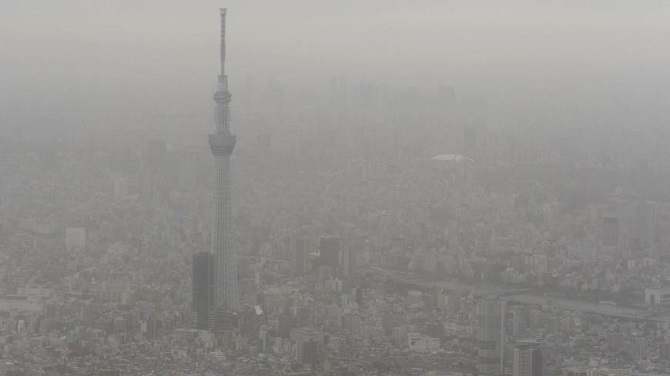Tokyo dust storm came complete with China sand

Yellow haze: Tokyo Skytree is barely visible through the dust Sunday.
The dust storm that hit Tokyo Sunday afternoon, causing watery eyes and reduced visibility, raised public health concerns and suspicions that the smog contained yellow sand and particulate matter from China.
The Meteorological Agency denied the allegation, explaining that the phenomenon was caused by a sudden cold front and strong winds in the Kanto region that roiled dust on the ground.
But Tetsuo Sakamoto, a professor of electrical engineering at Kogakuin University in Tokyo and an expert on pollution analysis, found yellow sand in a dust sample taken Sunday from Nerima Ward that apparently got mixed up with other dust.
“I believe Sunday’s (huge smog) indeed was caused by a dust storm (as the Meteorological Agency reported). But yellow dust (from China was in the mix),” Sakamoto told The Japan Times on Monday, hinting that PM2.5, or particulate matter 2.5 microns in diameter or less posing an increasing health risk in China and in some cases hitting Japan, was also in the smog.
Sakamoto studied the dust sample taken from the surface of a vehicle Sunday afternoon and found not only dust particles, but also calcium chlorite, which he said proves that Sunday’s smog also included yellow sand from China.
When dust from China floats over the ocean, calcium in it reacts with sea salt and turns into calcium chlorite, Sakamoto said.
Calcium reacts with sea salt and becomes calcium chlorite only when pollution particulate acts as an intermediary, leading Sakamoto to believe his sample flew over polluted areas in China before reaching Japan.
He said the yellow dust he found in the sample had apparently settled in Japan earlier but was whipped back up into the atmosphere by Sunday’s strong winds.
Sakamoto added that he did not study the concentration of yellow sand in the sample.
You can return to the main Market News page, or press the Back button on your browser.

